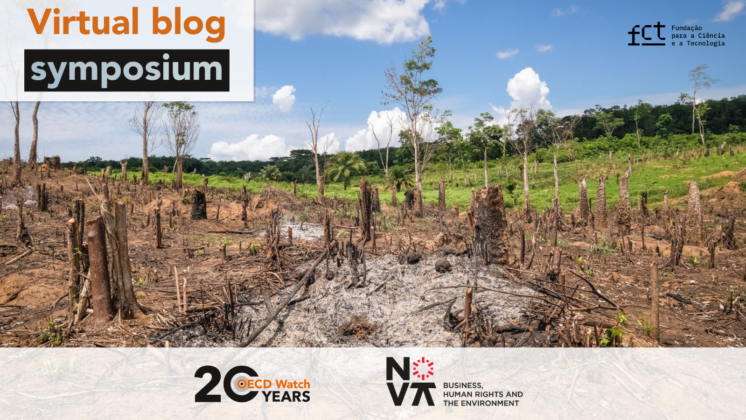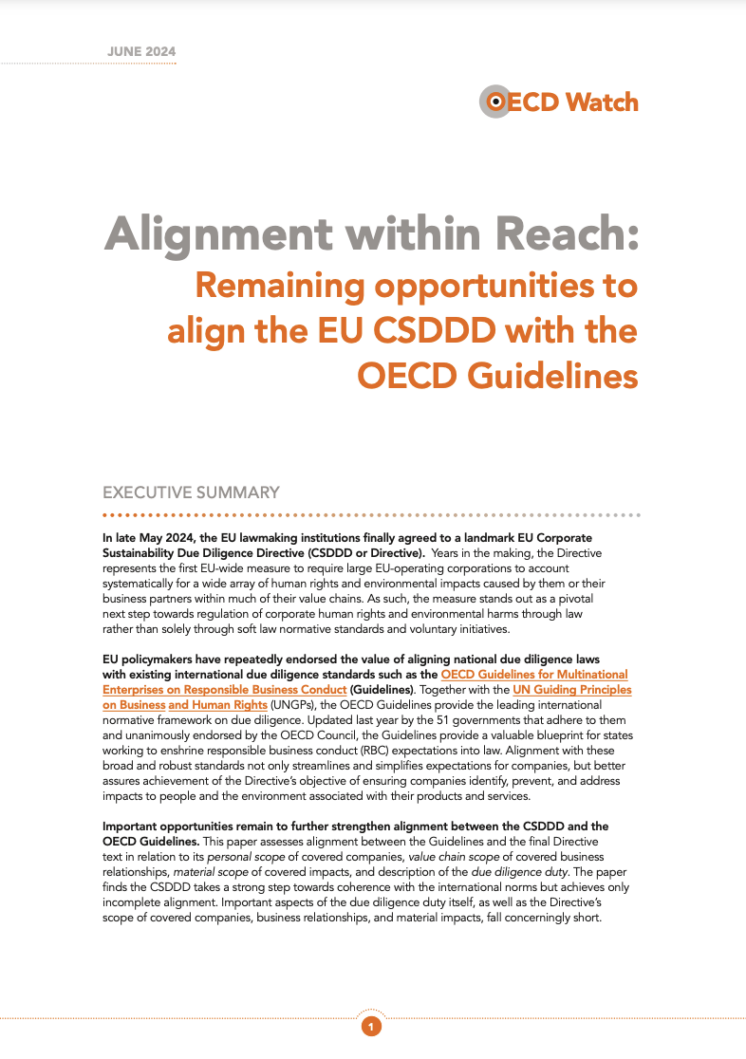By Chiara Macchi
Blog symposium co-organised by OECD Watch and NOVA School of Law

The 2023 edition of the OECD Guidelines for Multinational Enterprises on Responsible Business Conduct mark a significant step forward in the definition of corporate responsibility in the area of climate change. The 2011 version of the Guidelines, while not making specific reference to climate change, already contained a clear recommendation for corporations to perform environmental due diligence based on measurable objectives, and encouraged them to develop strategies for emission reduction, including through their products and services. The 2011 Guidelines also encouraged disclosure of accurate information concerning a company’s greenhouse gas emissions, an area in which reporting standards were still evolving, with the aim to monitor ‘direct and indirect, current and future, corporate and product emissions’ (Chapter III, Disclosure).
The 2023 edition, adopted by the OECD Council after conducting consultations with institutional stakeholders and with the wider public, markedly raises the ambitiousness and the specificity of the Guidelines’ climate due diligence recommendations. Climate change is now explicitly included in the non-exhaustive list of environmental impacts that guide the recommendations of Chapter VI, ‘Environment’. Compared to the 2011 edition, greater emphasis is placed on ‘risk-based’ environmental due diligence and prioritization, which requires taking steps that are commensurate to the severity and likelihood of the adverse impact. Whereas the 2011 edition encouraged the use of targets for improved environmental performance only ‘where appropriate’, the 2023 Guidelines recommend ‘establishing and implementing’ measurable science-based targets consistent with national policies and international environmental goals and commitments (Chapter VI, Guideline 1). The corporation’s environmental due diligence system must also include the provision of measurable information to the public concerning relevant environmental impacts, as well as providing for or collaborating in the remediation of the adverse impacts that it has caused or contributed to.
Multinational corporations must measure and reduce their greenhouse gas emissions…
These recommendations, which considerably strengthen the Environment chapter of the Guidelines, are then complemented with specific remarks on the climate change-related responsibilities of corporations. The Commentary to Chapter VI underlines the role of corporations in contributing to net-zero greenhouse gas emissions. While the role of businesses in the needed sustainability transitions is leveraged by both the Paris Agreement and Sustainable Development Goals, these frameworks, as explained by Jägers, view such involvement within a logic of partnership, not of corporate responsibility. The 2023 OECD Guidelines, instead, start from the proposition that multinational enterprises have a responsibility to ‘ensure that their greenhouse gas emissions and impact on carbon sinks are consistent with internationally agreed global temperature goals based on best available science’ (para. 76). This entails putting in place mitigation and adaptation strategies including short-, medium-, and long-term mitigation targets that need to cover scope 1 and 2 emissions as well as, ‘to the extent possibile’, scope 3 emissions. While not elaborated upon in detail, this part of the Commentary confirms that corporations should measure their direct and indirect emissions and ensure that their mitigation strategy aligns with the goals of the Paris Agreement. It also confirms that corporate responsibilities under the OECD Guidelines, unlike under the French Law on the Duty of Vigilance, also concern downstream supply chain relationships (see also Leonard Feld’s blog post for the symposium).
Even before the adoption of the revised Guidelines, the Dutch National Contact Point (NCP), in a specific instance concerning ING Bank, had affirmed that businesses must ‘seek measurement and disclosure of environmental impact in areas where reporting standards are still evolving’, including in relation to direct and indirect greenhouse gas emissions. The 2021 judgment against Shell in the Netherlands also elaborated on the responsibility of the multinational corporate group to cut its direct emissions, which the court defined as an obligation of result, and to produce ‘best efforts’ to cut its indirect, or scope 3, emissions, construed as a due diligence obligation. Although the Dutch court left Shell discretion on how to design the reduction strategy that would allow it to achieve the court-mandated 45% emissions reduction by 2030 (necessary to align with the Paris Agreement), it also emphasized the importance for the company to take responsibility for its scope 3 emissions, namely, for emissions produced by the group’s business relations and end-users, which constitute 85% of the Shell group’s total emissions.
A study of the African Commission on Human and Peoples’ Rights, whose draft has recently been published, elaborates on the duties of States and corporations under the African Charter of Human and Peoples’ Rights. In doing so, it recognizes that ‘corporations have the obligation to reduce greenhouse gas emissions from their own activities and their subsidiaries’ (emphasis added), as well as from their products and services. In addition, they must ‘minimize greenhouse gas emissions from their suppliers’, which once again suggests that their climate change responsibility extends to indirect emissions, albeit as an obligation of conduct. Thus, in emerging definitions of the climate change responsibility of transnational corporations, there is a clear expectation that companies will consider both direct and indirect emissions, as well as emissions from their downstream value chains. The revised Environment chapter of the OECD Guidelines reflects this trend.
…in a credible manner
In encouraging the adoption of science-based reduction targets, the 2023 OECD Guidelines refer to absolute targets but also, ‘where relevant’, intensity-based targets (para. 77). The latter approach sets the reduction targets as relative to an economic metric, for instance, to a certain amount of output. While this approach allows to factor in the corporation’s economic growth or other changes in circumstances, such as mergers and acquisitions, it is important to underline that implementing this type of target does not ensure an absolute reduction of total emissions. The wording of the OECD Guidelines, however, suggests that absolute reduction targets are essential, whereas intensity-based targets are optional.
The revised Guidelines also contain a crucial watershed between the responsibility to mitigate emissions, on the one hand, and carbon credits or offsets, on the other. The Guidelines are very clear in stating that corporations ‘should prioritise eliminating or reducing sources of emissions over offsetting, compensation, or neutralization measures’ (para. 77), which should only be considered as residual avenues (last-resort option) to address unabated emissions. To make the message clearer, the Guidelines underline that:
Carbon credits or offsets should be of high environmental integrity and should not draw attention away from the need to reduce emissions and should not contribute to locking-in greenhouse gas intensive processes and infrastructures (para. 77).
This specification is crucial, not only considering the doubtful environmental outcomes of this type of projects, but also the serious land-grabbing and human rights concerns too often associated with them. From a normative standpoint, the notion of corporate responsibility elaborated under the UN Guiding Principles on Business and Human Rights and incorporated into the OECD Guidelines since 2011 does not allow a corporation to ‘offset a failure to respect human rights’ by putting in place ‘other commitments or activities to support and promote human rights’ (UNGP 11, Commentary). Similarly, a multinational corporation must address its own climate change impacts, which will often require an absolute reduction of emissions, and cannot circumvent this responsibility by invoking the supposed positive social and environmental outcomes of carbon offsetting projects.
It is important to underline that the soundness of a corporation’s climate change action and communication could also be assessed under the Guidelines’ chapter on Consumer Interests (Chapter VIII), which deals with advertising and marketing practices, including environmental claims. Already in 2019, the UK NCP examined a specific instance against British Petroleum (BP) in which the accuracy of sustainability statements made in the company’s advertising campaign was questioned by the NGO ClientEarth. As BP withdrew the campaign in 2020, the NCP never issued a statement on the matter. However, it is to be expected that Chapter VIII, in conjunction with the improved Environment of the Guidelines, will form the basis for future ‘greenwashing’ specific instances before the OECD NCPs.
A lesson for the EU draft Corporate Sustainability Due Diligence Directive
The upcoming EU Directive on Corporate Sustainability Due Diligence can be a turning point in regulating the transnational activities of corporations, providing new instruments and remedial avenues to affected communities and to activists around the globe. In this respect, while it is commendable that the Commission’s draft includes an environmental due diligence dimension, it must be observed how corporate climate change responsibilities are addressed in a conservative manner. Relegated to one article of the draft Directive (Art. 15), climate change does not form an integral part of the fully-fledged due diligence strategy that the Directive would mandate. The European Parliament’s position adopted earlier this year proposes including climate change as an integral part of environmental due diligence, covering scope 1 to 3 emissions, but this is not the case in the current draft. Under the Commission’s 2022 draft, corporations are only asked to devise a climate change plan assessing whether climate change is ‘a principal impact’ of the company. Only if it is would the company be required to include emission reduction goals in the plan. Even then, the obligation would be to adopt mitigation objectives, not to implement or monitor them. Thus, while the climate change plan should ensure that the ‘business model and strategy of the company are compatible with the transition to a sustainable economy’ and the Paris Agreement, the design and contents of that plan can fundamentally be left to the corporation’s discretion. It is not clear whether such plans would be made public, which would at least allow some degree of monitoring on the part of the civil society. Joseph Wilde-Ramsing has identified three key lessons that the EU Directive, currently under negotiation in the institutional ‘trilogues’, could learn from the 2023 edition of the OECD Guidelines. I would add to those a fourth one, namely, including in the Directive’s final text a more ambitious climate due diligence dimension.
About the author
Chiara Macchi is Assistant Professor of Law at the Wageningen University – Law Group and author of the book ‘Business, Human Rights and the Environment: The Evolving Agenda’ (Springer, 2022). She has published articles on climate due diligence, extraterritorial human rights obligations and human rights due diligence legislation. Between 2019 and 2021, she led a Marie Sklodowska-Curie project on business and human Rights in the policies of the European Union.
About the blog symposium
2023 is a momentous year in the corporate accountability world. In June, not only did the OECD adopt key revisions to the newly renamed OECD Guidelines for Multinational Enterprises on Responsible Business Conduct, but the European Parliament also agreed on its position on the proposed directive on corporate sustainability due diligence. In recognition of these important events, NOVA BHRE and OECD Watch are co-hosting a blog symposium in October and November 2023 focused on the updated OECD Guidelines in the context of the current corporate accountability landscape.
The views and opinions expressed in this blog represent the views of the author and does not necessarily represent those of OECD Watch or NOVA School of Law.











